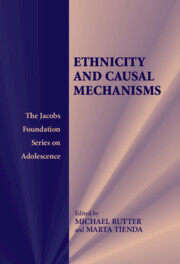Book contents
- Frontmatter
- Contents
- List of Contributors
- Foreword
- Preface
- 1 Natural Experiments, Causal Influences, and Policy Development
- 2 Growing Up Ethnic in the United Kingdom and the United States: Comparative Contexts for Youth Development
- 3 The Multiple Facets of Ethnicity
- 4 Educational Attainments: Ethnic Differences in the United Kingdom
- 5 Race and Ethnic Inequality in Educational Attainment in the United States
- 6 Racial and Ethnic Disparities in Crime and Delinquency in the United States
- 7 Explaining Ethnic Variations in Crime and Antisocial Behavior in the United Kingdom
- 8 Cultural Differences in the Effects of Physical Punishment
- 9 Ethnicity and Mental Health: The Example of Schizophrenia in the African-Caribbean Population in Europe
- 10 Ethnic Variations in Youth Suicide
- 11 Ethnicity and Intergenerational Identities and Adaptations in Britain: The Socio-Political Context
- 12 Assimilation, Dissimilation, and Ethnic Identities: The Experience of Children of Immigrants in the United States
- 13 Deciphering Ethnicity: Reflections on Research Opportunities
- Author Index
- Subject Index
7 - Explaining Ethnic Variations in Crime and Antisocial Behavior in the United Kingdom
Published online by Cambridge University Press: 05 July 2014
- Frontmatter
- Contents
- List of Contributors
- Foreword
- Preface
- 1 Natural Experiments, Causal Influences, and Policy Development
- 2 Growing Up Ethnic in the United Kingdom and the United States: Comparative Contexts for Youth Development
- 3 The Multiple Facets of Ethnicity
- 4 Educational Attainments: Ethnic Differences in the United Kingdom
- 5 Race and Ethnic Inequality in Educational Attainment in the United States
- 6 Racial and Ethnic Disparities in Crime and Delinquency in the United States
- 7 Explaining Ethnic Variations in Crime and Antisocial Behavior in the United Kingdom
- 8 Cultural Differences in the Effects of Physical Punishment
- 9 Ethnicity and Mental Health: The Example of Schizophrenia in the African-Caribbean Population in Europe
- 10 Ethnic Variations in Youth Suicide
- 11 Ethnicity and Intergenerational Identities and Adaptations in Britain: The Socio-Political Context
- 12 Assimilation, Dissimilation, and Ethnic Identities: The Experience of Children of Immigrants in the United States
- 13 Deciphering Ethnicity: Reflections on Research Opportunities
- Author Index
- Subject Index
Summary
Introduction
This review examines ethnic variations in crime and antisocial behavior in England to consider whether distinct patterns among ethnic groups have tended to persist from one generation to another. Analyzing intergenerational continuities among distinct ethnic groups is challenging because longitudinal data scarcely exist. In their absence, one can only examine ethnic variations in offending rates over time and consider whether these patterns have changed since the initial period of migration and settlement of ethnic minorities. Although the evidence for the early migrant cohorts is fragile, a striking pattern emerges. Crime and antisocial behavior increased among certain groups (African Caribbeans especially), but not at all among certain others (Indians, most clearly). Certain other groups (Bangladeshis, especially) may be intermediate, with signs of a recent increase among the youngest generation. These findings illustrate the great diversity of ethnic minority populations in Britain, and the complexity of their experience of British society. Subsequently I evaluate a range of possible explanations for the striking differences in offending patterns, and for the differences in ethnic continuity and change over the generations.
The reports on a program of research on ethnic minorities in Britain in the mid-1970s highlighted the diversity of the origins, language, religion, and post-migration history of the minority groups in Britain, which was reaffirmed by a subsequent study in the 1990s (Modood et al., 1997; Smith, 1977). Both studies document visible minorities’ shared experience of racial discrimination and prejudice, yet highly divergent integration experiences.
- Type
- Chapter
- Information
- Ethnicity and Causal Mechanisms , pp. 174 - 203Publisher: Cambridge University PressPrint publication year: 2005
- 2
- Cited by



